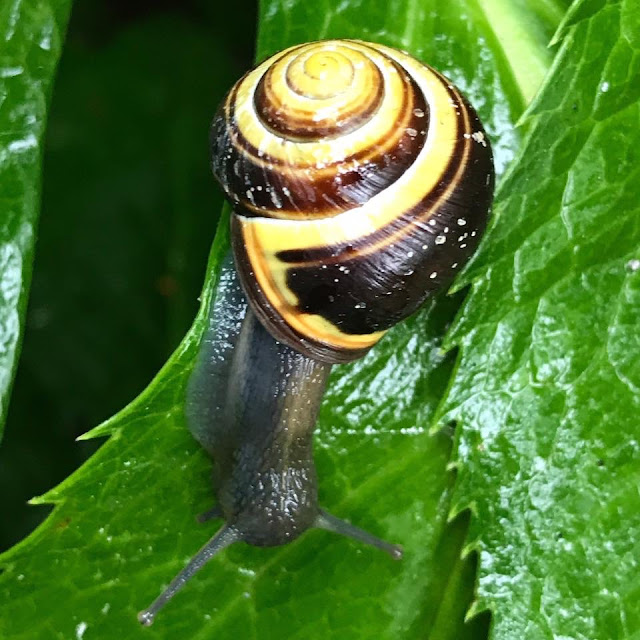Living Harmoniously with Slugs and Snails
 |
| Large snail in my garden |
The next approach I have, is to do with crops I grow in containers - for example lettuce leaves which I try to have each year. Again, this is doable because my garden is small and I would only have a few pots with edibles but I go out and do regular checks at night with a torch. This is weather dependent too and damp weather brings out the snails and slugs in force so you might have to be extra vigilant. It is important to note as well, that small seedlings are particularly vulnerable and will benefit from being covered or protected in some way. Once they are bigger, they have a bit more resilience and can survive a bit of eating.
*A method that works in flower beds is one which I discovered recently. I read about it and decide to give it a go - basically you just save your grapefruit halves and put them open side up near the plants you would like to protect. According to what I read, they would just fill with slugs/snails and they would be there in the morning ready to transport elsewhere. I gave it a go and came out the first morning to empty grapfruit halves! So although I left them in place, I wasn't that impressed with this method. However I went out last night to do a check on my vulnerable sunflowers which I put in the bed recently, and lo and behold, one grapefruit was teeming with little creatures.
I left them there but in retrospect, I should have probably moved them last night as they were mostly gone this morning. Interestingly enough, I have 4 sunflowers in the bed, one in a sunny spot which has had some damage (Photo 1), next 2 are quite close together near the wall but in an area packed with plants (Photo 2) and the last is in possibly the shadiest spot but a little bit further away from the wall than the others (and with no overhanging plants)(Photo 3). The third has next to no damage which surprised me, as it is in quite a shady area. The worst affected have been the two which are near the wall and close to other plants as it is both dark and there are lots of little damp areas where slugs and snails can hide under leaves and debris. So we will see if my sunflowers survive but this is certainly a method worth trying.
|
|
|
My final methods involve barriers which slugs don't seem to like. I have found copper tape to be very effective around the pots containing my salad leaves and my hostas. This is well worth getting - it can be a bit awkward to get on smoothly around certain pots but it seems to stay on nicely and does offer a good deal of protection from what I observed last year.
I have tried coffee grounds and eggshells to mixed results. Neither seemed particularly great at keeping slugs at bay but perhaps there might have been some small level of protection. Another type of barrier that I discovered last year was wool pellets. These do seem to work pretty well also and can be very good if you are trying to grow susceptible veg in pots - they won't really work for lettuce containers as they are too large but they are good for bigger plants that are spaced out a bit.
I don't use beer traps for the simple reason that they are basically killing slugs and I feel that they are important for biodiversity and as a food for birds, no matter how annoying they might seem!
 |
| Yellow and Brown Snail on leaf |
Source:
http://bioweb.ie/defending-small-slimy/
And for more of an indepth look at the balance of predators and pests, check out this video from Bruce of the Red Gardens on YouTube - his videos are fantastic anyway and well worth watching.
https://www.youtube.com/watch?v=t1kkxCc3q7I
*Added 3rd May 2020 to reflect new method I learnt about since original post.
You might like to also read my Gardening in the Pandemic post.









Copper sounds like a good method to keep them away I need to try it. Have you tried salt? does that keep them away or do you think that is a bit too inhumane?
https://aab-edu.net/
I have used salt in the past but ultimately gave it up because I just felt it was too cruel. The copper tape works really well though!
I was just thinking of slugs lately and using beer traps but felt quite queasy about it. This is absolutely brilliant to read - great to benefit from all your experience. DeeB :)
Thanks! I'm also experimenting at the moment with mini cloches made from plastic bottles, just to protect veg seedling when they are very small. We'll see how that goes! :)
I used squeezed out orange halves, and put them on the ground near vulnerable plants with the opening facing down. That really helped. Every morning, there would be lots of slugs inside which I then released into the wild. I have hardly any slugs in my garden, now it's the snails, but they are easier to spot and remove!
As far as I know, any citrus fruits would work. Not sure that they have to be intact, or if you can eat them first. I squeezed the oranges, and still had a good result!
That's great to know! I will try the oranges too cos I often use slightly older ones for juicing - and apologies for tardy reply, your comment had gone into spam so I didn't see it straight away.